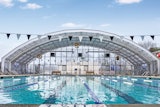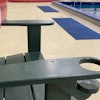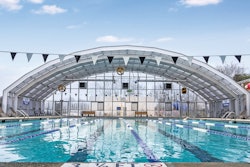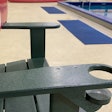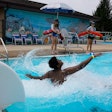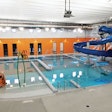
Aquatics professionals need no reminder that drowning is one of the leading causes of unintentional injury-related deaths, especially among children; they’re on the front lines — and pool decks — every day. They’re also facing a potential fourth consecutive summer of lifeguard shortages that not only could force some pools to reduce hours or shut down completely but also result in fewer eyes on the water when facilities are open.
With National Water Safety Month approaching in May, it’s critical to acknowledge the increasing ways technology is enhancing aquatic safety protocols at both public and private facilities.
Among the newest offerings is Dr. Tom’s Lifeguard Vision, a first-of-its-kind smartphone app that launched in January and simulates real-world active and passive drowning scenarios to allow lifeguards, aquatics supervisors and others to practice drowning detection and increase their awareness of drowning situations.
“This will help the lifeguard shortages, because we hope some facilities will make the app available to parents who come to the pool via a QR code,” says the app’s namesake, Tom Griffiths, president of the State College, Pa.-based Aquatic Safety Research Group, which created Lifeguard Vision. “They can download the app and practice at home. So, when they come to the pool, you’ll have a whole team of water watchers that have used the same app as the lifeguards. Just because there are certified lifeguards on duty doesn’t mean they can see everyone all the time. This way, you’re teaching members of the pool community how to see what’s happening in the pool just like a lifeguard sees it.”

WAVE Drowning Prevention Systems — which allows lifeguards to track the submersion duration of each swimmer via wearable technology on swimmers’ heads — launched in 2020 just before the COVID-19 shutdown and is now deployed in 25 states.
“A lot of times with safety technology, the early adopters are the people who need it least, because they’re super safety-conscious and they do a great job of hiring lifeguards and training them. But they’re very aware that drownings still happen,” says Mark Caron, WAVE’s chief executive officer and cofounder, noting that municipalities, YMCAs and Boys & Girls Clubs are the product’s primary users right now. “We’re essentially asking lifeguards to be 100 percent perfect 100 percent of the time, and humans aren’t very good at that.”
“Anything that managers and supervisory-level staff can do to keep lifeguards motivated — and help them remember that the most important thing they can do is be proactive in their scanning of the water when they’re in the chair — is so important,” says Courtney Clay, past president of the Association of Aquatic Professionals and aquatics supervisor for Mesa (Ariz.) Parks, Recreation & Community Facilities.
Clay also recommends engaging guards on break with a quick game of Spot It! (a party card game that requires observation and quick reflexes) or some other activity that helps them maintain focus and be ready to return to work. A round on Dr. Tom’s Lifeguard Vision app would work, too. Additionally, Clay notes, facility management should be on deck and regularly check in with lifeguards and other staff members throughout their shifts.
“A watched guard is a good guard,” she says.
 Image courtesy of Aquatic Safety Group
Image courtesy of Aquatic Safety Group
Lifeguards and new technology
Good guards have the potential to become great guards, which is why Griffiths developed Lifeguard Vision.
“The problem with lifeguarding is that guards don’t get to see a drowning until it’s often too late,” he says. “With the app, they have the ability to actually see a real-life scenario that has occurred numerous times, detect it, recognize it and stop it before it’s too late. This gives them the kind of practical training experience that pilots, soldiers and police officers receive.”
During the simulation, several avatars are in the pool at the same time — boys and girls, men and women, people of color — and they randomly appear on screen engaged in activities that include playing in the shallow end, jumping off the diving board and swimming laps.
When app users see an avatar in trouble, they blow a virtual whistle. The app responds by congratulating them and indicating how long it took to detect the victim. Scenarios include a breath-holding swimmer drowning and a lap swimmer experiencing a medical event. If the user misses a drowning, the app buzzes and indicates what was missed. Each simulation lasts about 15 minutes, according to Griffiths, and while all avatars and their actions are randomized, drowning scenarios are based on actual security video footage from aquatic facilities.
The indoor pool in the app is rectangular to match those at most schools and YMCAs, and an outdoor-pool setting is coming soon. The Starfish Aquatics Institute, a water safety training and certification agency, has expressed interest in incorporating the app into its programs, Griffiths says, and as the number of app users increases, updates will be made based on user feedback.
Although Lifeguard Vision is free to download from Apple’s App Store or the Google Play Store, users can unlock the full simulation for a one-time fee of $4.99. Aquatic facilities also can pay a licensing fee (beginning at $35 per year) to receive access to an admin portal that allows managers and supervisors to track staff usage and performance. Fees are based on the number of app users, but making money was never the objective, Griffiths insists.
“I’m committed to getting this out there to save lives,” he says. “My goal is to recover my monthly maintenance program expenses. I have no intention of ever recovering the cost of development, because I’ll never do it. I’m hoping I can generate enough income to keep my software developers and marketing team employed, to keep making the app better and better. If we could get 100 facilities — regardless of their size — to incorporate the app into their training, that would be a good start.”
One hundred is a big number for WAVE this summer, too. The technology’s first deployment was in Hobart, Ind., at a 50-meter high school pool that doubles as a community pool, and the 100th deployment is expected to take place sometime this spring.
“This kind of safety technology is still something totally new and different,” Caron says. “But it’ll hit a point where it’s not a question of ‘Do I do this?’ but ‘How do I justify not doing it?’ ”
The WAVE system involves the use of one-size-fits-all lightweight Tracker headsets or GoggleClips that easily attach to any pair of goggles. Both automatically activate when they sense motion, and they can be kept on a self-storage system in an easily accessed location. Hundreds of wearables are monitored simultaneously via The Hub, which is battery-powered, equipped with a strobe light and speaker, and overlooks the swim area. Referred to by WAVE Drowning Prevention Systems as the technology’s “brains,” The Hub communicates with the wearables twice every second to determine how long each swimmer’s face is fully submerged, according to the company.
Lifeguards wear a wireless, waterproof and rechargeable bracelet that vibrates to warn them when a swimmer has been underwater for a pre-determined period of time. As a result, Caron says, guards develop a better sense of how long swimmers can safely remain underwater. But if the swimmer remains submerged for an additional preset period of time, The Hub emits an audiovisual alert. Anytime a guard enters the water, the WAVE system issues remote spoken alerts throughout the facility, notifying other staff that assistance might be required. Optional Location Indicators mounted on walls, poles or floats in the swimming area can help guide lifeguards to that individual. When a swimmer resurfaces, warnings cease and the system resets.
A base WAVE package can be purchased for about $9,000 or rented for around $500 per month. Systems come co-branded with literature, signage, banners, decals and digital assets for websites and social media platforms.
“What we’re unique in doing is very precisely timing how long a swimmer’s face is underwater, and ultimately that’s the only thing that matters for drowning,” Caron says, while also acknowledging the use of video detection and other layers of protection that some aquatic facilities might use. “It doesn’t matter what the rest of your body is doing. If you’re face down, unconscious in three inches of water, you will drown.”

Grant money up for grabs
Investing in technology isn’t the only way to bolster water safety strategies. The Association of Aquatic Professionals allocates a minimum of $5,000 annually for its lifejacket grant program and another $5,000 for its swim lesson grant program — with the goal of purchasing and providing at least 500 lifejackets for organizations and providing a minimum of 100 free lessons to underprivileged participants.
All it takes is membership in AOAP and completion of the application process, according to Clay. The next deadline to apply for grants is July 1, followed by deadlines on Oct. 1, Jan. 1 and April 1.
Mesa Parks, Recreation & Community Facilities was awarded 25 lifejackets via the grant in 2022. Many of them were added to the city’s existing inventory of lifejackets at some of Mesa’s nine public aquatic facilities — including one that hosts Pachanga en la Piscina (“Party in the Pool”), a free annual family event focused on water safety.
“We use them as part of our swim lesson program — how to put on a lifejacket and what lifejackets are used for,” Clay says, adding jackets in multiple sizes are stored on a rolling cart. “We also have them as part of our public swims, and they are used frequently.”

Statistics indicate that drowning death rates for Black swimmers are 1.5 times higher than they are for white swimmers. Which is why Mesa’s facility operators strive to hire a diverse group of lifeguards that reflects the communities those facilities serve, the idea being more swimmers might feel more comfortable in the water. This approach also breaks down barriers for “kids in the community who see lifeguards that look like them and then realize they can be one, too,” says Clay, who has written about the importance of helping trans lifeguards feel included, as well. “We’re trying every day to make diversity an important part of our staff culture.”
She admits the role of an aquatics supervisor can be a stressful one and — given the daily life-or-death responsibilities that come with overseeing a pool facility — professionals shouldn’t hesitate to seek out additional resources from peers or share their own insights with others.
“If you’re not sure about what to do, just ask,” Clay says. “I sometimes feel like we should know all the answers, because we’re the facility operators. But it’s okay to ask. We should all support each other and help each other succeed.”










